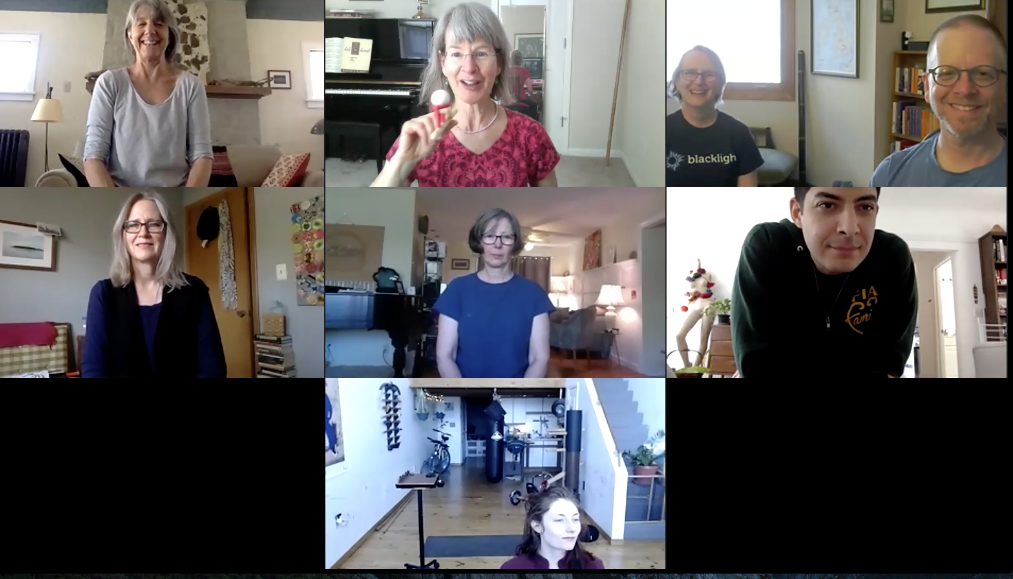The adventure of online classes and lessons
Alexander teachers are accustomed to giving and receiving huge amounts of subtle information through our hands. In a time when we can’t be near each other, I decided to embrace the new terrain of online teaching by offering classes and lessons. I began with great trepidation and was very pleasantly surprised by the degree of subtle connection that can happen. And… it’s fun!
The Technique at its heart is a process of attention and intention. You learn to be more skillful with the use of your attention, which helps you become more elastic and dynamic. Students who get my ‘Alexander Spark’ email series will know what I mean when I say that exploring our ‘Sparky’ options online together really does seem to help us meet our current circumstances more creatively. I look forward to when in-person / hands-on lessons can resume, but this is definitely a most worthy adventure!

Now for some input from my wise and witty colleague Jeanne, speaking to the challenges and opportunities of life on Zoom:
Screen world: learning, teaching and use
Posted by Jeanne Barrett on April 2, 2020
How we connect, teach and learn has changed dramatically in recent weeks. The glowing screen has become our necessary means, our gathering place and our latest challenge in the use of our selves. The following includes some of what I am learning as the screen becomes my means.
Eyes and ears: while teaching or learning via a screen, our vision and hearing become vehicles for information. As an Alexander teacher, my hands are typically my primary instrument to receive and convey information. Now, my eyes and my ears are my hands, in a sense. My initial tendency in learning and teaching online was to reach with my eyes and ears, and to pull myself toward the screen. I was narrowing and shortening to see and hear. Not what I want to best use myself, and I want my best use of self to teach well.
Today, in giving a “lesson” to a TaiJi instructor (who also is teaching online), we experimented with allowing vision and hearing from the entire breathing back. This allowed us both to receive information, rather than strain to get it.
Voice: As in early cell phone days, I noticed myself shouting at the screen in my urgency to connect. My throat and neck hurt after my first days of online teaching, which is certainly not what I want (and rather embarrassing for an Alexander teacher). So, instead, I allow numerous dynamic pauses in which I request (cheerfully and with happy curiosity) the ground to support my resonance. I welcome the entire space around me, especially behind and above me, to transform the wave of breath to sound and tone. Throat and neck are no longer sore, even as I increase lesson scheduling.
Words: Teaching online is an ongoing improvisation, during which I am responding to my student on the screen, and to what my student reports about experience in the moment. Dynamic pauses of even a few microseconds allow the words to arrive from my entire instrument rather than just my over-eager self. The words compose themselves when I welcome the ground, request a larger attention, and include a cheerful refusal to “get it right”.
The entire self: just as in any lesson I am giving, or class I am taking, all of me is necessary for the most productive outcome. Decades of teaching with my hands refined this entirety of response, this unified field of self. It is an entirely new experience for me to teach (or learn) by the current means, but my intention is to rise to demand with all of me. So, I take a moment before a lesson begins to ask my arms and legs to undo out of my entire breathing back, to fix less, undo more overall, to receive gravity as the source of my elastic response, and to embrace the not knowing that a new experience requires.
www.activestillness.com

Comments
The adventure of online classes and lessons — No Comments
HTML tags allowed in your comment: <a href="" title=""> <abbr title=""> <acronym title=""> <b> <blockquote cite=""> <cite> <code> <del datetime=""> <em> <i> <q cite=""> <s> <strike> <strong>